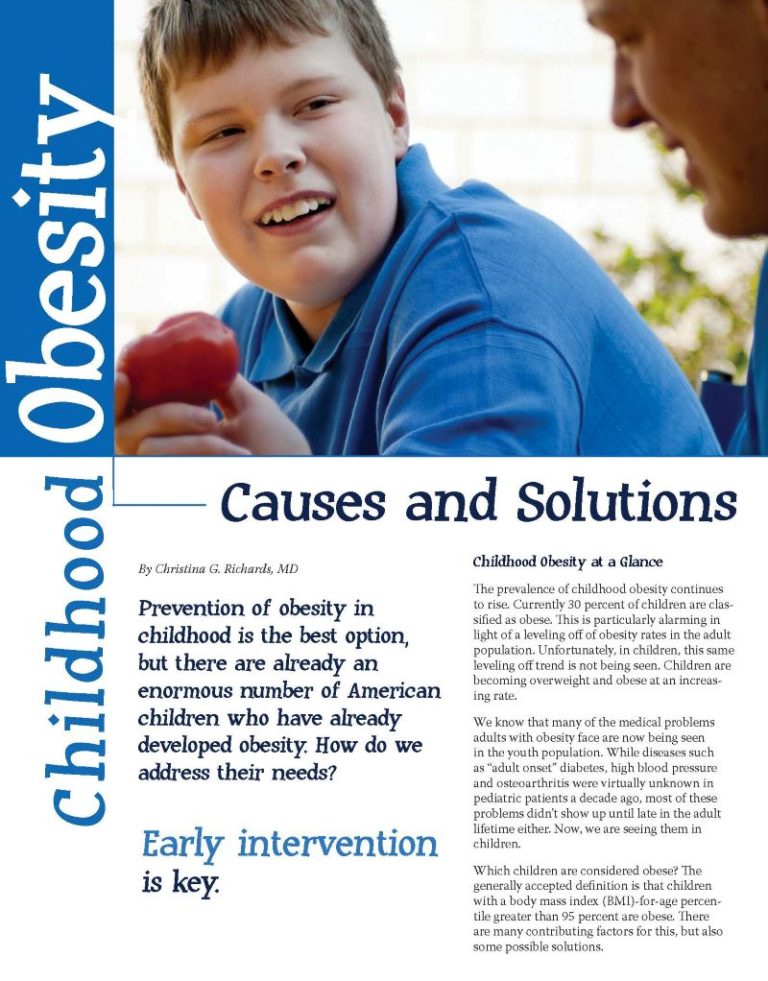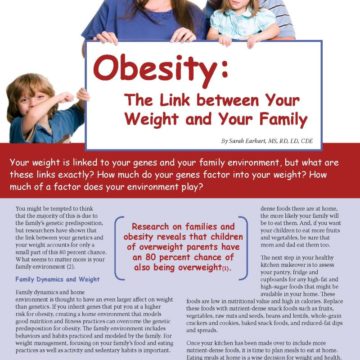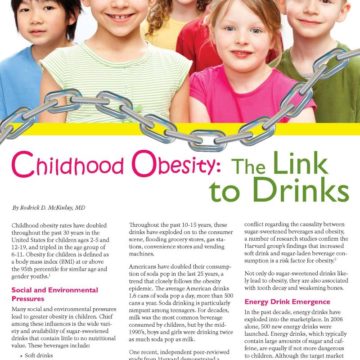Childhood Obesity – Causes and Considerations


by Christina G. Richards
Spring 2010
Prevention of obesity in childhood is the best option, but there are already an enormous number of American children who have already developed obesity. How do we address their needs? Early Intervention is key.
Childhood Obesity at a Glance
The prevalence of childhood obesity continues to rise. Currently 30 percent of children are classified with obesity. This is particularly alarming in light of a leveling off of obesity rates in the adult population. Unfortunately, in children, this same leveling off trend is not being seen. Children are becoming affected by excess weight or obesity at an increasing rate.
We know that many of the medical problems adults with obesity face are now being seen in the youth population. While diseases such as “adult onset” diabetes, high blood pressure and osteoarthritis were virtually unknown in pediatric patients a decade ago, most of these problems didn’t show up until late in the adult lifetime either. Now, we are seeing them in children.
Which children are considered to be affected by obesity? The generally accepted definition is that children with a body mass index (BMI)-for-age percentile greater than 95 percent are affected by obesity. There are many contributing factors for this, but also some possible solutions.
Changing the Way We Eat
We know that the way we eat has changed considerably throughout the last 30 years. Children are eating more and differently than they did before. There are bigger portions offered and consumed and a greater reliance on snack foods and sugary beverages. Whereas in the past, sugar consumption was a relatively minor part of our diet, now almost all processed foods (including staples such as peanut butter, breakfast cereal and canned foods) add sugar.
We know that babies offered more sugar develop a preference for these foods – often to the exclusion of more healthful and necessary nutrients. Sugary beverages such as sodas ,which fairly recently were rare “treats,” have become a mainstay of many diets. Larger portions are also a problem. Children offered more food tend to overeat.
There is a solution, though. Parents can make a huge difference by offering different foods to help children develop a preference for more healthful choices with better nutrition. Substituting made from scratch options for processed foods means that you know what is in the food and minimizes additives and surprises such as added sugar. Making big batches of foods and freezing leftovers for later is key.
Parents and our society as a whole need to be more involved in advocating for healthier choices for school lunches and eliminating “junk” food from vending machines. These foods may be as addictive as cigarettes. A good rule of thumb is to avoid things with more than 10 grams of sugar per serving.
Another important dietary intervention is adding more fruits and vegetables. Make sure cut up and pieces of vegetables (baby carrots, snap peas, celery, etc.) are front and center in the refrigerator. Grocery stores have learned to position foods they want consumers to buy at eye level. Parents and caregivers can do the same.
Make sure the fruit bowl is full and offer fruit regularly as a dessert or snack. We know that vegetables and fruits provide vitamins and minerals and have important anti-cancer properties and lots of fiber to make you feel full longer.
Increasing Exercise
Another big difference in how we live, which contributes to childhood obesity, is less exercise. There are several factors contributing to this:
- The rise of video game popularity
- Elimination of recess and physical education from school curriculum
- More automation
- Increased concern for safety
Again, there are possible solutions to all of these factors. As adults, we are not nearly active enough. Exercising and playing together as a family can be important for strengthening the family bond as well as benefiting our overall level of activity. Play basketball together, go on a walk or hike instead of watching TV together. Many families really enjoy Wii Fit™ programs or Dance Dance Revolution™ as alternatives to more sedentary video games.
Schools have been eliminating recess and PE from their curriculum for several reasons. As budgets get tighter, these programs are seen as superfluous and are often the first programs on the chopping block. In addition, in a more competitive world, physical activity is seen as secondary in importance to academic subjects. There is actually good evidence to support better brain development and better ability to concentrate and perform on test taking in children who regularly participate in vigorous physical activity. Again, advocacy on behalf of our children can make a difference in making sure these important activities are preserved.
Safety concerns cannot be underestimated as a cause for decreased activity. Parents are more concerned about sending the children out to play. There are safe options available and walking the kids to school or riding bikes together as opposed to driving them is a good way to increase everyone’s level of activity.
Socioeconomic status also plays a role in childhood obesity. We know that children from economically challenged backgrounds have higher rates of obesity. This is partly due to little education about nutrition in those with a limited education, as well as a restricted access to nutritional options.
Helping Kids Already Affected
We know that if we can intervene and make changes before adolescence, kids will be less likely to be adults with obesity.
The best way to start is to call your nearest children’s hospital and ask for their resources for treating overweight children. As the problem of childhood obesity has become widespread, programs to address this are also being developed. A program specifically targeted at children is more likely to be successful than one tailored to adults. Also, there are medical conditions, which can lead to obesity, which need to be ruled out.
Conclusion
Our country’s children are now facing a life expectancy, which, for the first time in history, is shorter than that of their parents. Most of this is due to problems resulting from obesity. We have an obligation to do what we can to prevent and treat obesity. It takes a major commitment and lifestyle changes on the part of all of us. But, we really do want what is best for our children, and that means making some choices. The good news is that these changes not only benefit our children, they benefit the adults in these children’s lives as well.
About the Author:
Christina G. Richards, MD, is a bariatric surgeon in Salt Lake City, UT. She founded the Surgical Weight Loss Center of Utah in 2003 where she is committed to providing a comprehensive approach to weight-loss and surgery.
by Sarah Muntel, RD Spring 2024 Spring has sprung, bringing sunnier and warmer days! For many, this…
Read Articleby Yelena Kibasova Spring 2024 The fitness world is evolving, with new trends and innovations that promise…
Read Articleby Zack Lucks, NASM-CPT, EMT Winter 2024 Working out with a loved one is a great way…
Read Article








